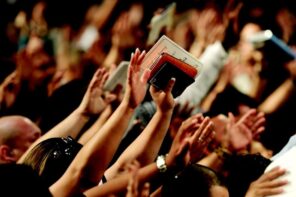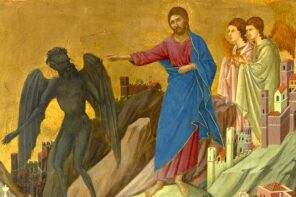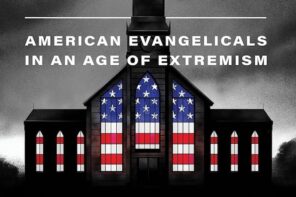You could be forgiven if, after watching the 2020 Democratic and Republican party conventions, you thought that the religious community in the U.S. was pretty uniformly anti-abortion.
Although reproductive choice and justice got a sprinkling of mentions at the Democratic convention, there was nothing from an explicitly prochoice religious perspective. However, Fr. James Martin, a liberal Jesuit priest, closed the convention with a prayer in which he asked God to “Open our hearts to those most in need.” On his list was “The unborn child in the womb.”
Three days later, Roman Catholic Cardinal Tim Dolan opened the Republican convention with a prayer in which he highlighted “the innocent life of the baby in the womb.” Speakers throughout the convention linked their antiabortion views with their vision of God and country.
While the GOP has sought to rally its base, and the Democrats continue to chase antiabortion religious voters on the margins (as they have for years), both parties ignore the vast prochoice religious community in the United States. Trump sought, for example, to rally his base by issuing an executive order on the occasion of his video address to the National Catholic Prayer Breakfast, stating he will be “signing the Born-Alive Executive Order to ensure that all precious babies born alive—no matter their circumstance—receive the medical care that they deserve.” This came on the eve of a similar address to the annual Values Voter Summit, hosted by the Family Research Council, and sponsored by leading Christian Right organizations, including AFA Action and the Truth and Liberty Coalition, and news outlets, The Christian Post and the Bott Radio Network.
The Democratic Party’s faith outreach operations have focused on evangelicals and Catholics without a whiff, of course, of expressions of religious prochoice values.
More generally, there is nothing remotely analogous going on in the prochoice religious community in terms of ongoing voter identification, mobilization, and building a movement with the skills required to prevail in electoral democracy—let alone stage events able to command the attention of senior politicians and governmental decision makers. It might seem like a fantasy to suggest that such things might be possible, but the numbers suggest that it’s not.
Vast resources, historic roles
A Pew study of views on abortion between 1995-2019 found that “public support for legal abortion remains as high as it has been in two decades of polling. Currently, 61% say abortion should be legal in all or most cases, while 38% say it should be illegal in all or most cases.” Other reputable pollsters have shown similarly increasing support for abortion rights, which has been widely reported.
Pew also found that support for abortion rights among religious and non-religious people combined is now at the highest level in history. Data further suggest that a majority or near majority of religious people in the United States may, in fact, be prochoice.
While the Roman Catholic Church, by far the largest Christian group in the U.S., is institutionally opposed to abortion in all instances, and actively suppresses dissenting views, Pew reported in 2019 that 56% of rank-and-file Catholics believe that abortion should be legal in all or most cases. Pew also found that 60% of individual “White Mainline Protestants” and 64% of “Black Protestants” believe that abortion should be legal in all or most cases. Pew data also reveal significant prochoice minorities among Mormons and White evangelicals.
A number of leading mainline Protestant denominations are officially prochoice, including The Episcopal Church, the United Church of Christ, the Presbyterian Church (USA), and the Evangelical Lutheran Church in America. As is most of organized Judaism. There are also deeply considered prochoice theological traditions within all of major world religious traditions present in the United States, including Islam, Buddhism, and Hinduism. Taken together, they have vast resources, institutional capacity, historic and central roles in many towns and cities, and cadres of well-educated leaders at every level. These are the kinds of human, cultural and institutional resources that can sustain a powerful political movement.
All this may be a revelation to those who’ve been conditioned by the false narrative that people of faith oppose and secular people support abortion rights, that has framed much of our national conversation. The dismantling of this false narrative would open the possibility for fresh religious, cultural and political visions—as well as organizations and actions—to have a presence in the public square and the institutions of democracy.
This couldn’t happen too soon.
This is unfolding at a time when all sides think that the time is just over the horizon that Roe v. Wade will be overturned or substantially diminished. The passing of Supreme Court Justice Ruth Bader Ginsburg and Trump’s nomination of a Catholic antiabortion jurist, Amy Coney Barrett has cast the likelihood of this future in sharp relief.
Meanwhile, the Christian Right’s approach to the long game of electoral power politics has resulted in a Christian Right minority, led by politically animated White evangelical Protestants, exercising electoral power disproportionate to their numbers. According to data compiled by PRRI, from 2006 to 2018, the White evangelical Protestant share of the national vote increased from 23% to a steady 26%, even while its share of the population declined from 23% to 15%.
This has happened because the Christian Right for decades has made extraordinary efforts to find, engage, and turn out voters likely to be sympathetic to their cause across election cycles. But there’s no analogous sustained organizing in the moderate-to-liberal religious community with the broad political and electoral vision and ongoing development of related skills and practices that define the Christian Right. But there could be.
Some may argue that a religious prochoice political movement would be little more than a funhouse mirror of the Christian Right and the institutions that undergird it. That would be a good argument—except that the most prochoice religious institutions also embrace religious freedom, pluralism, and separation of church and state—the very constitutional values that were intended to thwart theocratic politics and governance from the founding of the United States. Those same institutions also have democratic polities, which is to say that they elect their own leaders, and evolve their theological statements and public policy positions through considered democratic processes, in sharp contrast to the antiabortion religious institutions that generally do not.
This is important to note, not only for the future of reproductive choice and justice, but democracy itself. While anyone who reads the news knows that there’s a real decline in religious identity and institutional membership, less well recognized and reported is that this decline in organizational identity and membership isn’t unique to religious institutions. In fact, as detailed by Harvard political scientist Robert D. Putnam in his 2000 book Bowling Alone. membership organizations of all kinds have been in decline for decades.
But unlike most membership organizations, prochoice Christian churches have been the target of a war of attrition by Christian Right agencies led by conservative Catholics and evangelicals, seeking to displace them from the center of American culture. This effort is still underway, led by the Washington, DC headquartered, Institute on Religion and Democracy, which was originally a project of the neoconservative Coalition for a Democratic Majority.
The stakes in the decline of prochoice Christian churches, (and the continuing siege against them) aren’t limited, however, to matters of reproductive rights, access and justice. Putnam observed that the trend of overall decline in democratic membership organizations means that there’s been a concomitant loss of opportunities for people to learn and practice relevant knowledge and skills for engagement in democracy. Churches, he observed, “are one of the few vital institutions left in which low income, minority and disadvantaged citizens of all races can learn politically relevant skills and be recruited into political action.”
The prochoice religious community papers
But if the prochoice religious community were to get organized to the point of becoming politically influential—even powerful—in the post-Roe era, it would help to know which prochoice religious institutions exist and how to find them for a future fraught with challenges but imbued with hope and possibilities. The sheer numbers, profound cultural resonance, and vast institutional infrastructure of these institutions and the communities they serve suggests great hope and possibility for a resurgent prochoice religious community of historic consequence.
The “Directory of Prochoice Religious Organizations in the United States,” published today, along with a paper from which this article was drawn, by Political Research Associates (full disclosure: RD is under the umbrella of PRA) may be seen as a rough map of the prochoice religious landscape and suggest multiple starting points for those who want to mobilize toward a better future. Also part of the prochoice religious community papers are the proceedings of an online colloquium organized by PRA and response papers by researcher and former PRA Fellow, Rachel Tabachnick, and Patti Miller, former Senior Editor at RD and author of Good Catholics: The Battle Over Abortion in the Catholic Church.
There’s much to be learned from the experience of evangelical parachurch organizations, operating outside of traditional religious denominations. Contrary to popular belief, the strength of the Christian Right is concentrated less in the megachurches, than in ecumenical parachurch organizations. The likes of Campus Crusade for Christ and Youth with a Mission paved the way for more explicitly political organizations like the Christian Coalition of the 1990s, and the Family Research Council and Family Policy Alliance of the 2000s.
But of course if the prochoice religious community were to create parachurch organizations of their own in which matters of reproductive choice, access and justice were central rather than marginal concerns, and if these were political entities (as discussed in the prochoice religious community papers) they would not need to ape the culture and structure of the evangelical and Catholic agencies that comprise the Christian Right. They would certainly envision and invent a culture, organizations, structures and activities that are consistent with their own democratic cultures and values. Additional differences would likely be that while denominationally oriented, or ecumenical Christian trans-denominational political groups are options, so are multifaith groups.
The closest thing to such a politically oriented parachurch organization with at least a suggestion of a prochoice orientation is the Poor People’s Campaign, led by Rev. Dr. William Barber II and Rev. Dr. Liz Theoharris. (The Campaign is a contemporary continuation and revival of the Poor People’s March launched by Martin Luther King Jr.) The campaign denounces the Christian Right and antiabortion movement as a cover for and continuation of the White Christian political supremacism that became morally unacceptable in the wake of the Civil Rights movement.
They recognize that the barriers to access to abortion care that is the main strategy of the anti-abortion movement, disproportionately affects poor women of color, particularly in rural areas. The Campaign’s Jonathan Wilson-Hartgrove, told a conference in January 2020, that the Christian Right persuaded many Christians to “to keep the same people in power.” That, he says, was the message that “was sold to my people with organizations and lots and lots of money.”
Like most other religious social justice organizations, the Campaign doesn’t take an official position on reproductive rights, access, or justice—although it welcomes people who do.
If it’s true, as a 2019 NPR-PBS Marist Poll had it, that 77% of respondents think the Supreme Court should uphold Roe v. Wade, then it’s also true that this isn’t well reflected in politics, policy, and media coverage. This presents the perfect opportunity for the prochoice religious community to rise to moral and political leadership. The Christian Right has an ideological, cultural, and electoral strategy designed to accomplish their ends, and the prochoice religious community does not. This needs to change. And it could. Because one lesson we can take from the historic political successes of the Christian Right is that power isn’t in the polls, it’s in the organizing.
The entry of a politically vibrant prochoice religious community into democratic public life might be transformational in the history of reproductive freedom, access, and justice. It just might also transform the way that both parties do politics and government as well.





